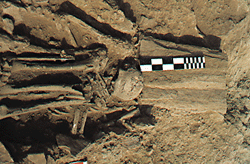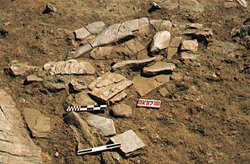

Architectural and anthropological remains which date to the Mesolithic
period (10,000-8000 BP) were traced at the site Maroulas on the island
of Kythnos.
The archaeological site of Maroulas, estimated to be about 2000 square metres, is situated beside the sea which has evidently eroded a part of the Mesolithic settlement. The excavations, admittedly not very extensive, brought to light intact human skeletons at a depth of just a few inches below the earth surface. These are among the first known burials in an open site in the Aegean, along with the those found previously in some caves of Attica, at Franchthi in Hermionid, at Theopetra in Kalambaka and Yioura near Alonnissos.

Beside the burials the first relics of Mesolithic houses in Greece
were found belonging to a paved floor which was probably part of a type
of "house".
The presence of architectural remains and burials on the same site suggests
that a community of hunter-gatherers settled here for a long time in
order to practise also fishing and shell-collecting.
Although the study of other finds from the excavation, lithic and stone
artefacts as well as bones, has yet to be completed, the remains unearthed
at Maroulas are particularly important since the study of the Mesolithic
Period in Greece has been based on finds which so far have come from
a limited number of sites.
The discovery of other sites apart from the one on Kythnos, on Alonnissos
and the Cyclops Cave at Yioura, combined with the established use of
obsidian
at Franchthi Cave in Hermionid, have provided concrete evidence that
the Aegean islands (Cyclades and Sporades) had already been explored
at certain times of the year and inhabited by the early phase of the
Holocene.